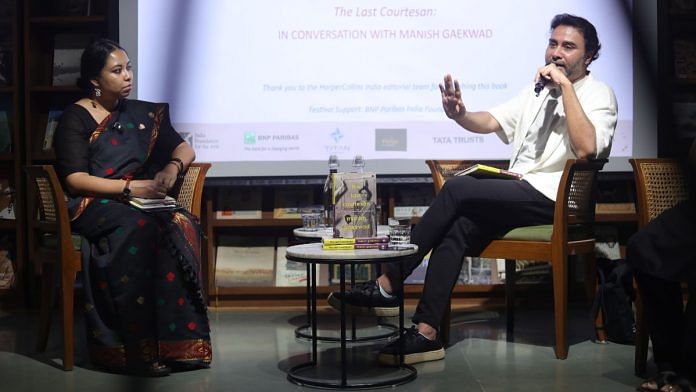Bengaluru: A mother’s life, a son’s memory and a lost world of women kotha performers can be a heady yet challenging cocktail for a book.
For long, Madhubala’s Mughal-e-Azam and Rekha’s Umrao Jaan were the only popular culture reference points for a bygone era. Glamour and glory followed many of the portrayals. The 1980s saw several movies where the courtesan was the stoic, sacrificing foil to the male protagonist. And then Sanjay Leela Bhansali’s Heeramandi brought glamour and glory —and “tawaifs love it,” said the author of The Last Courtesan Manish Gaekwad.
His mother Rekha Devi’s story is a thrilling saga of guns, gangs, and Ghalib’s ghazals. The Last Courtesan unfolds with the flair of a 1980s Bollywood action film, yet dives deeper, capturing Rekha Devi’s resilience and artistry.
Bangalore International Centre (BIC) recently hosted a book talk, ‘Guftgu’, with Gaekwad in conversation with researcher Mridupankhi Rajkumari as part of a three-day arts research festival, Past Forward, organised by the India Foundation for the Arts (IFA).
Gaekwad offers an unmediated and unfiltered account of what would have otherwise remained an oral history of a tawaif, bringing to light hidden histories that lie in families like his own.
The Last Courtesan tells the story of tawaif Rekhabai who made a name for herself in Calcutta and Bombay as a singing-dancing star. The book’s challenge, Gaekwad said, was telling an authentic story even as he peeled the intimate terrain of a mother-son relationship.
“I had moved out of the Kotha at a young age. I was in a boarding school in Darjeeling, so I spent little time with mum, it was a very chatty relationship with her rather than a ‘maa ka dulara’ (momma’s boy) kind. I was mostly detached from the story myself, so I could afford to be objective as a listener while I wrote her story,” he said.
Also read: ‘Mujra, tawaif not bad words’—Classical dancer rescuing courtesan culture from British gaze
A place in the archives
Gaekwad told the story of how The Last Courtesan came to be written in his mother’s voice, and how Rekhabai remembered her life and navigated her past using the music (and films) of her time. It very smoothly tied into the main theme of IFA’s festival—the importance of archives in research.
“I had the privilege of being an insider, so the erasure that usually comes from tawaifs and musicians talking to a person they don’t know– that didn’t happen with me,” he said.
Gaekwad archived her stories as she verbally narrated them to him over six months. He wrote her stories initially in his voice. But he said that it made more sense to compile her life story in her own voice, in the first person, rather than translating her story into formal English and taking away control over her own narrative. Gaekwad brought a lot of Hindi-Urdu words into the text. “That’s how she spoke, and that’s the language of her story– why change it? Why interrupt a woman while she is talking?”
When an audience member asked how Gaekwad kept track of the timelines, genealogy, and names while writing her memoir, he succinctly replied, “music holds memory. We used music to go back in time”. The book is filled with references to Bollywood songs and ghazals.
Also read: Kathak, Odissi meets academia and India’s courtesan history is rescued from footnotes
Books over film
Gaekwad chose book over film to tell his mother’s story. Films are a form of escapism, he said, they’re never accurate to reality. “The tawaifs recognise that ‘films bhi wahi jadoo karte hain jo hum kothe pe karte hain,’” he said. (Films perform the same kind of magic that we perform in the kotha).
He added that all the depictions of sex workers and tawaifs that have been shown in Bollywood don’t matter—“it is fiction”.
“Films are secondary. Filmmakers may make whatever they want,” Gaekwad said, as a popular saying in cinema goes, “films don’t owe anything to literature.”
However, he added that he hopes this book survives the test of time. But with fewer people reading, he recognises that the only way to do that is through film.
“We don’t have a budget for a film. Hopefully, someone with the capacity will buy the book, read it and perhaps buy rights and immortalise it in film.”
(Edited by Theres Sudeep)






